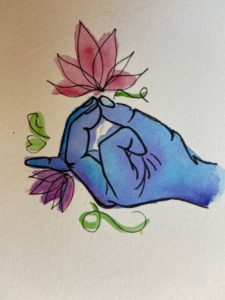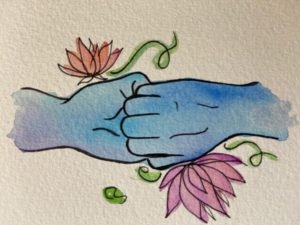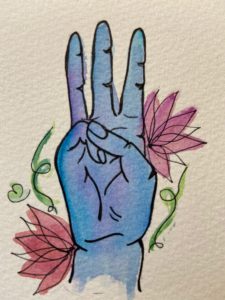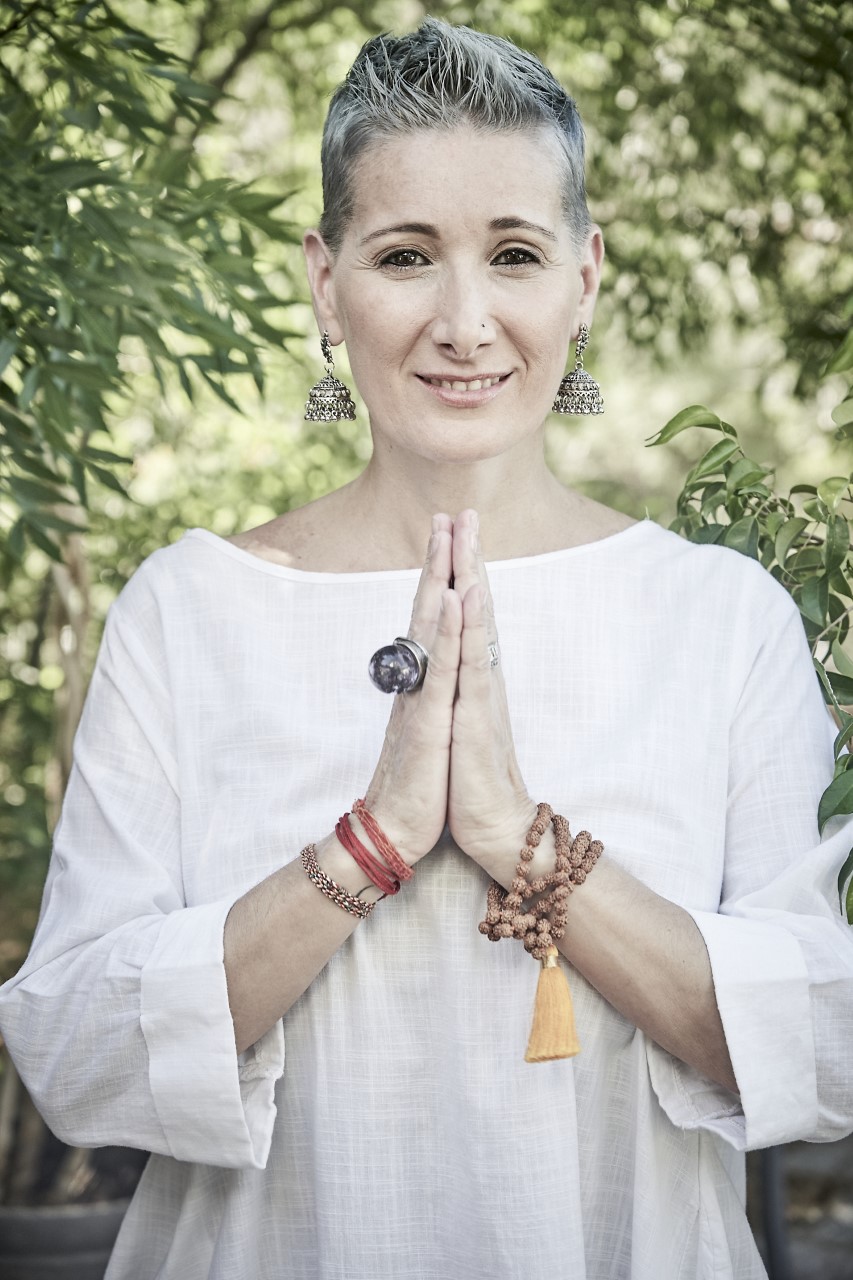Mudras can be practiced during meditation, yoga practice, or just in silence and contemplation. Ideally, you want to find a neat, quiet, and peaceful place to practice.
Our hands and fingers are an important part of our physical body and often a neglected one. Through our hands, we have the ability to connect with others and ourselves, to express emotions, communicate, give, and receive. Think about all the things that you do with your hands and fingers. You caress the people that you love, extend your hands to help those in need, and many other gestures of love and kindness. Of course, our hands can be the source of pain and suffering, but when we operate from the high frequency of love, our hands only can bring compassion and care. Our hands become an extension of our Consciousness.
Hinduism shows the earliest recorded knowledge and use of mudras, although mudras are found in many cultures and traditions, in particular in Buddhism and Jainism teachings. Mudra is a Sanskrit word that can be translated as “seal,” “mark,” or “gesture”; mudras are hand and finger gestures that help channel our energy. Mudras are used in religious rituals, spiritual dancing, prayer, meditation, Yoga, and Ayurveda.
Vedic philosophy teaches us about the oneness of all beings and that separation is just an illusion of our ego. As we understand the concept of Collective Consciousness, we understand that we do not heal in a vacuum, nor do we operate from the individuality of our being. What we create and become is part of a collaboration, many times invisible to our physical eyes. In the same way, learning mudras is part of an integrated practice; mudras are used in Ayurveda to enhance our psychical health and balance our doshas; during the practice of Yoga and Pranayam to increase concentration and prana flow; or during meditation to connect with our Self. However, these practices are not separated from each other but a part of each other.
Mudras are a part of the big cosmic spider web of the most ancient spiritual practices, so always approach them with respect and awareness.
MUDRAS AND AYURVEDA
According to Ayurveda, everything in the Universe is made of the Five Great Elements or Pancha Mahabhutas. These elements are Ether or Space (Akash), Air (Vayu), Fire (Agni), Water (Jala), and Earth (Prithvi). The elements are also present in our body and will determine our Prakriti or Dosha in the moment of our birth. There are three doshas: Vata (Space and Air), Pitta (Fire and Water), and Kapha (Water and Earth). Depending on which element is more predominant in our body, our constitution can be Vata, Pitta, or Kapha or a combination of the three.
Perhaps you are thinking, how can mudras relate to Ayurveda and the elements?
Each finger is connected to one of the elements: the thumb is connected to the element of fire; the index connects with the element of air; the middle finger with ether; the ring finger to earth; and the little finger is connected to the element of water. When we bring them together during the practice of mudras, the elements interact with each other, balancing them and enhancing our health. Depending on the mudras that we practice, it will bring balance to our Vata, Pitta, or Kapha dosha, or to all of them.
HOW TO PRACTICE?
Mudras can be practiced during meditation, yoga practice, or just in silence and contemplation. Ideally, you want to find a neat, quiet, and peaceful place to practice. Start by bringing awareness to your body and connecting with your breath. Allow your mind to focus on each inhalation and exhalation. Acknowledge any sensations, emotions, or feelings that may arise, yet do not attach yourself to them. Become an observer of your own experience. Sit in a comfortable position with your spine straight and take two deep relaxing breaths, inhaling slowly through your nose, retaining the breath for a few seconds, and exhaling out through your mouth freely. Take a third deep long grounding breath, inhaling slowly through your nose, retain your breath as it rises through your body for a few seconds, and slowly exhaling out through your nose, emptying your lungs completely. Proceed with your natural, effortless breath, in and out through your nose, and start with the mudra practice.
You can start by practicing five or ten minutes a day and increase the time as you feel.
A FEW MUDRAS TO PRACTICE
Apan Vayu Mudra

This is a very powerful mudra that is believed to improve the health of our heart. The elements involve in Apan Vayu mudra are ether, fire, and earth.
To perform this mudra, fold the index finger to touch with the tip the base of the thumb, with your middle and ring finger, touch the tip of the thumb while keeping the little finger straight and pointing outward. Folding the index finger into the base of the thumb helps reduce the air element decreasing Vata dosha, which can relieve pain and relax the body and the mind.
The connection between the thumb, middle and ring finger increases the fire and the earth elements, which helps you to detoxify and cleanse the body, supplying more oxygen to the heart arteries and increasing the power of the heart.
This mudra can also help you relieve headaches, toothaches, backaches, or pain in the joints.
Ganesha Mudra

This is one of my favorite mudras, and it is named after the Hindu god Ganesh, who is considered the remover of obstacles. Practicing this mudra is said to bring self-confidence and courage to overcome anything that is holding one back. Ganesh, as well as being the “remover of obstacles,” is said to sometimes place obstacles in one’s path so that we can gain strength by overcoming them.
To practice this mudra, place the left hand in front of the chest with your palm out and grasp the left hand with the right hand. Keep your hands at the level of the heart and energetically pulled them apart without releasing the grip. Inhale as you pull, hold the breath and the pull as per your lung capacity and strength, and then exhale slowly through your nose as you slowly let go of the pull.
Ganesh mudra is associated with the element of fire; therefore, it helps to stimulate our metabolism and digestion. Some practitioners said that they experience strong feelings of warmth and brightness in the heart area when practicing this mudra. This mudra can be very good for those suffering from heartache, depression, or sadness. Physically, Ganesh mudra is good for strengthening the muscles of the arms, chest and shoulders, and it helps to release tension in these areas.
Jalodar Nashak Mudra

The name for this mudra comes from the Sanskrit jal “water,” udar “stomach,” and “nashak” meaning, “finish.” Jalodar is also the Sanskrit term for “edema,” which is the swelling of soft tissues resulting from an abnormal accumulation of fluid.
To practice, place the tip of the little finger at the base of the thumb, and the thumb gently touches the back of the little finger. The remaining three fingers should be extended yet relaxed.
This mudra helps you to reduce the swelling throughout the body, stops excessive urination, relieves heavy menstruation and cramps, removes impurities from the blood, restores skin moisture, and treats excessive salivation, runny nose, and watery eyes.

By Esther Rodriguez Brown was born and raised in Barcelona, Spain. Since a very young age, she showed her passion for helping others and got involved in several social justice organizations.
She arrived in the United States in 2001 and in 2007 she founded The Embracing Project (TEP), a grass-roots non-profit organization that services children survivors of sex trafficking and gang violence. Until she opened TEP drop-in center, the first in Nevada for children survivors of trafficking, she served youth in the streets of Las Vegas using her car as her main office and many times opening the doors of her home for those youth who needed it. Esther traveled around the world to continue her service to humanity and in particular, children and women survivors of trauma, expanding services in several countries. In 2019, Esther merged TEP with a national organization to focus on her other passion, holistic healing, Yoga, Ayurveda, and Jyotish.
Esther founded Ego Friendly Living in 2016, a company based on the principle of compassion, self-healing, and self-empowerment, focusing on body, mind, and soul, through the practices of self-care and self-love. Her experience working with vulnerable populations and survivors of complex trauma gives her a unique perspective to facilitate healing practices and to teach how trauma can affect our emotional and physiological bodies.
Esther has a master’s degree in Psychology. She is an Ayurvedic Health Counselor, Vedic Astrologer, and a 200 YTT with studies in Yoga Nidra. Esther travels yearly to India to continue her studies related to body, mind, and soul to share that wisdom with others.
She is the author of The Power of Your Hands. Mudras for your everyday life. Available in Amazon. She is a recognized national and international speaker and has been recognized in national and international media, documentaries, books, and film and has received many awards for her humanitarian work with children affected by violence.
Find her on Instagram @Esther_Brown_Inspire









